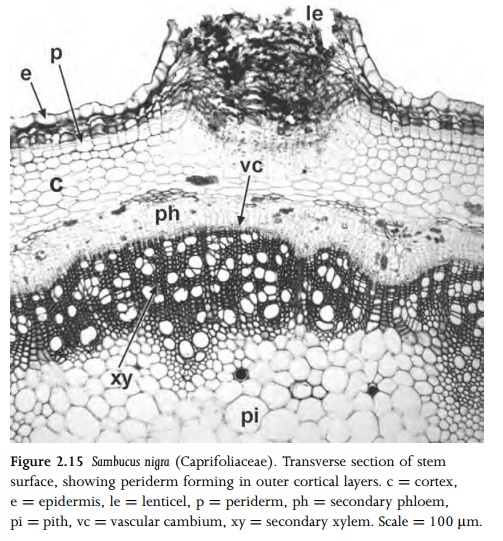Chapter: Anatomy of Flowering Plants: An Introduction to Structure and Development : Stem
Periderm
Periderm
Periderm
is a protective tissue of corky (suberinized) cells that is produced either as
a response to wounding or in the outer layers of the cortex of a stem or root
that has increased in thickness. The periderm consists of up to three layers:
phellogen, phellem and phelloderm. The phellogen is a uniseriate meri-stematic
layer of thin-walled cells that produces phellem to the outside, and (in some
cases) phelloderm to the inside. The phellem cells constitute the corky tissue.
They are tightly-packed cells that lack contents at maturity. They possess
deposits of suberin and sometimes lignin in their walls, and form an impervious
layer to prevent water loss and protect against injury. Phelloderm cells are
non-suberinized and parenchymatous, and contribute to the secondary cortex.

A
periderm commonly occurs in the cortex of secondarily thickened stems, to
replace the epidermis, which splits and peels away (Fig. 2.15). The phellogen
may originate either adjacent to the epidermis (or even within the epidermis)
or deeper in the cortex. Sometimes several phellogens form almost
simultaneously. The pattern of periderm formation largely dictates the
appearance of the bark of a woody plant. For example, the smooth papery bark of
a young silver birch tree (Betula pendula) is formed because the periderm
initially expands tangentially with the increase in stem diameter, but later flakes
off in thin papery sheets asabscission bands of thin-walled cells are formed.
In the trunk of cork oak (Quercus suber), the initial phellogen may continue
activity indefinitely, and produces seasonal growth rings. In the commer-cial
process it is removed after about 20 years to make way for a second, more
vigorous phellogen, which produces the commercial cork.
Many
species possess lenticels in the bark (Fig. 2.15); these are areas of loose
cells in the periderm, which are often initially formed beneath stomata in the
epidermis, and are thought to be similarly concerned with gaseous exchange.
Related Topics